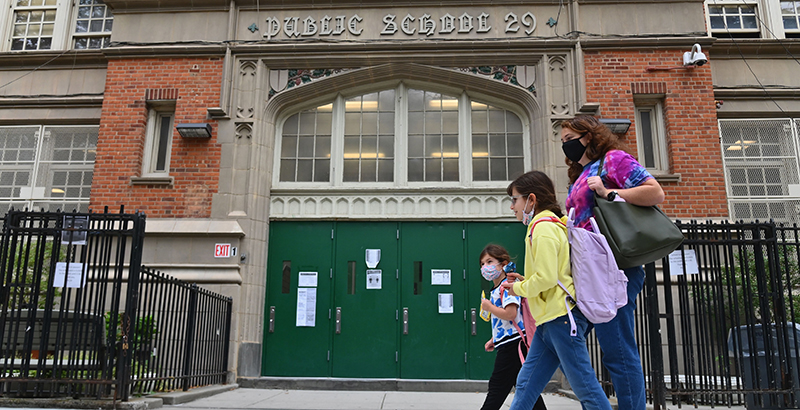Pondiscio: After 2 Years of Uncertainty and Shaken Trust, America’s Relationship With Its Public Schools Is in Play Like Never Before

Get stories like this delivered straight to your inbox. Sign up for The 74 Newsletter
Americans have an enduring, though contradictory, fondness for local institutions. On the whole, it can be summed up as “it’s bad out there, but it’s fine where I am.” Polls have long shown Congress is held in low regard bordering on naked contempt, for example, but everyone’s own representatives are somehow immune from that harsh judgment. Your congressman is far more likely to retire or decline to seek another term than to lose a reelection bid. We evince a similar skepticism toward the health care industry, yet few professions are more trusted than doctors and (especially) nurses.
This same phenomenon has long been true of schools. For decades, Americans have given failing grades to public education at large, but we regard the schools our own children attend as the exceptions to the rule, with solid majorities giving local schools grades of A or B.
Because of this dynamic, when advocates for private school choice, charters, online education, microschools, homeschooling and other alternatives to traditional public schools were heralding the arrival of a “new normal” (or, more cynically, a crisis too good to waste) in the early days of the pandemic, I cautioned skepticism. Our enduring fondness for local schools suggested that public education would snap back into its old normal shape at the earliest possible moment. The overwhelming majority of American children — 85 percent before the pandemic — attend zoned public schools. This figure cannot be fully explained away by a lack of alternatives, or a failure of imagination or entrepreneurship. It suggests the persistence of a valued cultural habit. We simply like sending our kids to local public schools and mostly think they’re pretty good.
But here we are, deep into a third consecutive school year disrupted by COVID-19, or living under the threat of it, and the evidence is now mounting and irrefutable that Americans’ relationship with local public schools is not as solid, reliable or unshakable as it has been historically.
To say 2021 was the “year of school choice” elides the fuller picture. True, there were new and expanded choice initiatives in more than 20 states, potentially affecting about 4.5 million students. But it was also the year of just about everything else. The unprecedented visibility of remote school Zoomed directly into millions of American homes raised questions about both class content and instructional rigor. Angry parents protesting at school board meetings were likened to domestic terrorists. What were they angry about? You name it: critical race theory, activist teachers and woke curriculum. Staying in person, going remote. Gender-neutral bathrooms and book bans. Mask mandates and a lack of mask mandates. It was also the year that public education fell into the voracious maw of partisan politics, becoming a prominent issue in Virginia’s governor election, rewriting political scripts and playbooks for the 2022 midterms and perhaps the next presidential election.
Add it all up, and it seems uncontroversial to suggest that the historically solid and reliable relationship of most Americans with their neighborhood schools has never in living memory seemed more in play than at present.
One needn’t be a social justice activist or angry parent to question your relationship with the neighborhood school, however. There’s an even simpler phenomenon at work: inertia. It is not an indictment of local schools (or at least not intended as one) to say that among their most salient features is predictability. The rhythms of the school year largely dictate family life. Your kids have somewhere they’re supposed to be Monday through Friday for 40 weeks of the year. Working families are accustomed to making plans for their children well in advance for summer vacation and winter recesses — not the night before, when schools close due to staffing issues or when your child is quarantined weeks at a time out of an abundance of caution to stop the spread of COVID. The less reliably schools are open and accommodating, the more likely parents are to make other plans. Two years and counting of uncertainty and improvisation is, frankly, too much to ask of parents. It’s plenty of time for new habits to form and to stick.
The cracks in the foundation are visible and growing. Just before the holidays, NPR compiled head-count data from more than 600 school districts in 23 states and the District of Columbia. They found that very few districts, especially larger ones, have returned to pre-pandemic attendance levels: New York City’s school enrollment dropped by about 38,000 students last year and another 13,000 this year. In Los Angeles, the head count declined by 17,000 in the 2020-21 school year and nearly 9,000 this year. Chicago is down nearly 25,000 since the start of the pandemic. All told, there was a 3 percent decline in public school enrollment, which adds up to about 1.5 million children. “Many families simply opted out of remote learning in the non-compulsory grades of pre-K and kindergarten,” NPR reported. “School leaders hoped this year would bring recovery.”
It hasn’t.
Will this exacerbate inequity? I don’t see how it can’t. Parents who have the means and motivation have already made other plans. Those who lack resources can’t and won’t. The data suggest significant numbers of students have already slipped through the cracks, ending whatever tenuous relationship they had with formal education. Some older kids are exiting the education system altogether; in 2020, US colleges saw a 13 percent decrease in first-year enrollment compared with pre-pandemic rates, while high school dropout rates surged. Community college enrollment is also down sharply.
The extent to which this turbulence presages a permanent change in America’s habits of educating its children will remain unclear for some time. But the responses across the education sector have been instructive to watch. Schools of choice that are accustomed to competing for students have been more likely to remain open for in-person instruction and have reaped the benefit of increased enrollment. Many families flocked to Catholic schools, which were committed to remaining in person; “Across the nation, the Catholic school approach is to stay open wherever we are allowed,” said Tom Carroll, superintendent of Catholic schools for the Archdiocese of Boston. At the same time, charter school enrollment grew 7 percent and homeschooling rates tripled over the course of the pandemic. Other families opted for smaller, boutique options, like learning pods and private tutors.
Most telling is the apparent lack of urgency among the public school establishment, particularly teachers unions, to getting kids back in school or to keeping them there. They seem stubbornly determined to push parental patience to its limits and beyond. Despite the overwhelming evidence that remote learning has harmed students’ academic and social development, especially for children from disadvantaged backgrounds, many districts are still closing as a first resort, not a last one, whether it’s to stop the spread of COVID, deal with staffing crunches or provide mental health days for staff and students.
The staunchest defenders of public education as an indispensable institution argue that public schools provide a common good that goes beyond academics. Yet it’s often those very same “defenders” insisting schools be closed and access restricted. “The damage wrought to students, particularly those from historically marginalized communities, during a time when our children and parents so desperately needed the stability and resources of schools was self-inflicted and flew in the face of mounting evidence for well over a year,” observes Paymon Rouhanifard, a former school superintendent who last year cast the only vote against a statewide masking mandate on the Massachusetts Board of Elementary and Secondary Education. The failure to prioritize the well-being of children has troubled him for more than a year. “Frankly, it’s unforgivable,” he says.
It’s long been a popular notion among school choice advocates to suggest that education is no different than any other category of goods or services and should be subject to the same market pressures, but this is a grand oversimplification. In truth, our relationship with a school is closer in kind to that of a church or an employer than a restaurant or grocery store: You don’t switch casually or quit in a fit of pique. It would take a perfect storm of parent frustration, political upheaval and respectable alternatives to disrupt the long-dominant paradigm of sending our children to a convenient and trusted local school.
But that perfect storm is exactly what’s been brewing since March 2020. And the forecast seems to suggest it’s not over yet.
Robert Pondiscio is a senior fellow at the American Enterprise Institute. He is the author of the book “How the Other Half Learns” (Avery, 2019). Jessica Schurz contributed reporting for this essay.
Get stories like these delivered straight to your inbox. Sign up for The 74 Newsletter

;)
